-
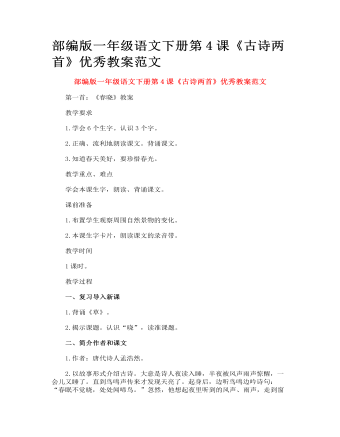
部编版一年级语文下册第4课《古诗两首》优秀教案范文
指导写字 觉:“学”下面的的“子”换成“见”。 夜:第四笔是“竖”,不要写成“竖钩”。注意指导笔顺,提示不要漏写第七笔“点”。可与熟字“衣”比较字形的异同。 雨:仿佛隔窗观雨。里面左右各两点,上下排列,像檐下滴水。 声:上面是“士”,不是“土”。下面的最后一笔是“丿”,不是“竖弯钩”,不能写成“巴”。 知:左边是把“午”的“竖”改撇,再加一点。右边是“口”表示知道了要用口说出来。 少:上面与“小”不同,第一笔是竖,没有钩。
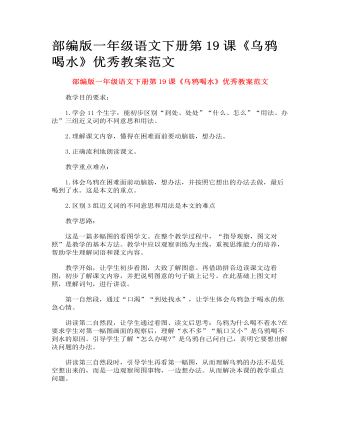
部编版一年级语文下册第19课《乌鸦喝水》优秀教案范文
教学思路: 这是一篇多幅图的看图学文。在整个教学过程中,“指导观察,图文对照”是教学的基本方法。教学中应以观察训练为主线,重视思维能力的培养,帮助学生理解词语和课文内容。 教学开始,让学生初步看图,大致了解图意。再借助拼音边读课文边看图,初步了解课文内容,并把说明图意的句子做上记号。在此基础上图文对照,理解词句,进行讲读。 第一自然段,通过“口渴”“到处找水”,让学生体会乌鸦急于喝水的焦急心情。 讲读第二自然段,让学生通过看图、读文后思考:乌鸦为什么喝不着水?在要求学生对第一幅图画面的观察后,理解“水不多”“瓶口又小”是乌鸦喝不到水的原因。引导学生了解“怎么办呢?”是乌鸦自己问自己,表明它要想出解决问题的办法。 讲读第三自然段时,引导学生再看第一幅图,从而理解乌鸦的办法不是凭空想出来的,而是一边观察周围事物,一边想办法。从而解决本课的教学重点问题。
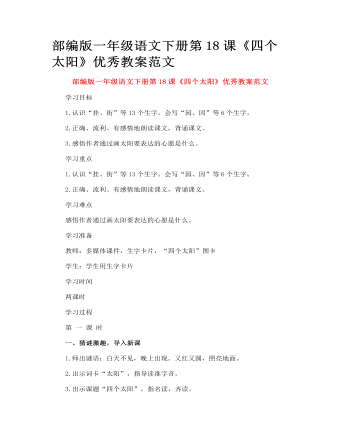
部编版一年级语文下册第18课《四个太阳》优秀教案范文
猜谜激趣,导入新课 1.师出谜语:白天不见,晚上出现。又红又圆,照亮地面。 2.出示词卡“太阳”,指导读准字音。 3.出示课题“四个太阳”,指名读,齐读。 4.引导质疑:读了课题,你的小脑瓜里是不是蹦出了小问号? 二、初读课文,认记生字 1.出示课件:带拼音生字,指名带读。 2.出示课件:去拼音生字并打乱顺序,摆字卡,自由练习朗读。 3.游戏:我说你找喊名字。 4.指导识记生字方法。 5.巩固游戏:我把生字送回家。动画演示,指导写字 1.猜谜引入:大口框里有个“大” 2.出示课件:“因”书写笔顺规则 看了动画,你知道了什么? 3.出示课件:“园” “园”与“因”哪里长得很像?书写的时候要注意些什么?(同样先里面后封口) 4.师范写“园”“因”,讲解书写要领。 5.生自由练写,师巡回指导。 6.集体评价。
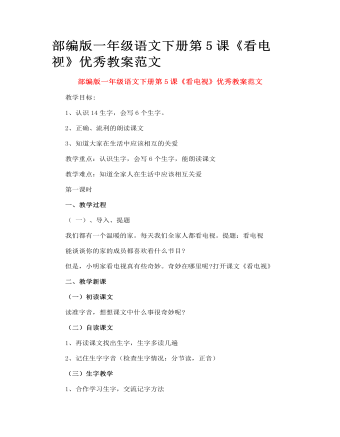
部编版一年级语文下册第5课《看电视》优秀教案范文
教学新课 (一)初读课文 读准字音,想想课文中什么事很奇妙呢? (二)自读课文 1、再读课文找出生字,生字多读几遍 2、记住生字字音(检查生字情况:分节读,正音) (三)生字教学 1、合作学习生字,交流记字方法 2、出示词语巩固生字 (四)写字教学 “全家”两字教学 (五)读懂课文 1、 再读课文,读懂后让你上来排顺序 爸爸和我———足球迷 奶奶———京剧 听的入迷 打盹睡觉 爸爸和我———足球 乐的直叫 一起拍手欢 妈妈 ———音乐 舞蹈 2、 找出把足球赛转成京剧的小节? 爸爸再看球赛时想到了什么? 3、 结果奶奶听的入迷,我和爸爸都在打盹睡觉。 奶奶又怎么想了呢? 找出京剧换成足球这一节?
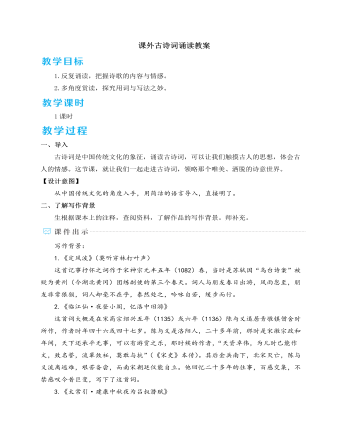
人教部编版语文九年级下册课外古诗词诵读(2)教案
【示例二】我喜欢“斫去桂婆娑,人道是,清光更多”。这里的“桂婆娑”指带给人民黑暗的婆娑桂影,它不仅包括南宋朝廷内外的投降势力,也包括了金人的势力。作者在这一句中,运用神话传说,以超现实的奇思妙想,表达渴望扫除黑暗,让光明普照人间的愿望。【设计意图】在这一环节,引导学生先理解词作的意思和情感再诵读,加深学生对词作的印象,提升学生对词作的诵读感悟能力。五、反复诵读,默写诗词1.学生独立背诵。2.同桌互相检查背诵。3.开展背诵比赛。4.集体默写四首词。结束语:诵读古诗词,可以陶冶我们的情操,激发我们的想象力,与古人对话。希望同学课下能自主阅读一些经典古诗词,在感受它们魅力的同时提升我们的文学素养。【设计意图】在前面几个环节,学生已经从不同层次诵读了四首词,对这四首词有了一定的理解。本环节让学生在此基础上用不同方式背诵,加深记忆。

新人教版高中英语必修3Unit 1 Festivals and Celebrations-Reading and Thinking教学设计
The topic of this part is “Discover the reasons for festivals and celebrations.The Listening & Speaking & Talking part aims at talking about the experiences and feelings or emotions about the festivals and celebrations. This section aims at detecting the reason why the people celebrate the festivals, the time, the places, the types and the way of celebrations. It also explains why some traditions in the old celebrations are disappearing, like the firecrackers in the big cities and some new things are appearing like the prosperity of business or commerce. 1. Students can talk about what festivals they know and the reasons and the way of celebrating them.2. Students should learn the reading skills such as the headline and get the topic sentences, the structures of articles.3. Students can understand the past, the present situation of some festival around the world and why there are some changes about them. 4. Students can have the international awareness about the festivals.1. Students should learn the reading skills such as the headline and get the topic sentences, the structures of articles.2. Students can understand the past, the present situation of some festival around the world and why there are some changes about them.Step 1 Lead in---Small talkWhat festival do you like best ? Why ?I like the Spring Festivals because I can set off the fireworks, receive the lucky money and enjoy the Gala with my families.Step 2 Before reading---Pair workWhy do people celebrate different festivals ?The Spring Festivals is to celebrate the end of winter and the coming of spring and new life.The Mid-autumn Day is to celebrate the harvest and admire the moon.
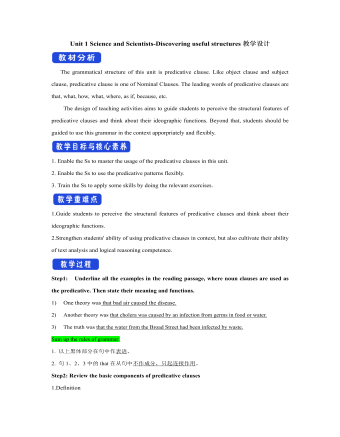
新人教版高中英语选修2Unit 1 Science and Scientists-Discovering useful structures教学设计
The grammatical structure of this unit is predicative clause. Like object clause and subject clause, predicative clause is one of Nominal Clauses. The leading words of predicative clauses are that, what, how, what, where, as if, because, etc.The design of teaching activities aims to guide students to perceive the structural features of predicative clauses and think about their ideographic functions. Beyond that, students should be guided to use this grammar in the context apporpriately and flexibly.1. Enable the Ss to master the usage of the predicative clauses in this unit.2. Enable the Ss to use the predicative patterns flexibly.3. Train the Ss to apply some skills by doing the relevant exercises.1.Guide students to perceive the structural features of predicative clauses and think about their ideographic functions.2.Strengthen students' ability of using predicative clauses in context, but also cultivate their ability of text analysis and logical reasoning competence.Step1: Underline all the examples in the reading passage, where noun clauses are used as the predicative. Then state their meaning and functions.1) One theory was that bad air caused the disease.2) Another theory was that cholera was caused by an infection from germs in food or water.3) The truth was that the water from the Broad Street had been infected by waste.Sum up the rules of grammar:1. 以上黑体部分在句中作表语。2. 句1、2、3中的that在从句中不作成分,只起连接作用。 Step2: Review the basic components of predicative clauses1.Definition
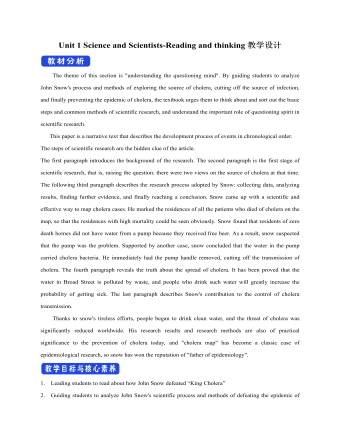
新人教版高中英语选修2Unit 1 Science and Scientists-Reading and thinking教学设计
Step 5: After learning the text, discuss with your peers about the following questions:1.John Snow believed Idea 2 was right. How did he finally prove it?2. Do you think John Snow would have solved this problem without the map?3. Cholera is a 19th century disease. What disease do you think is similar to cholera today?SARS and Covid-19 because they are both deadly and fatally infectious, have an unknown cause and need serious public health care to solve them urgently.keys:1. John Snow finally proved his idea because he found an outbreak that was clearly related to cholera, collected information and was able to tie cases outside the area to the polluted water.2. No. The map helped John Snow organize his ideas. He was able to identify those households that had had many deaths and check their water-drinking habits. He identified those houses that had had no deaths and surveyed their drinking habits. The evidence clearly pointed to the polluted water being the cause.3. SARS and Covid-19 because they are both deadly and fatally infectious, have an unknown cause and need serious public health care to solve them urgently.Step 6: Consolidate what you have learned by filling in the blanks:John Snow was a well-known _1___ in London in the _2__ century. He wanted to find the _3_____ of cholera in order to help people ___4_____ it. In 1854 when a cholera __5__ London, he began to gather information. He ___6__ on a map ___7___ all the dead people had lived and he found that many people who had ___8____ (drink) the dirty water from the __9____ died. So he decided that the polluted water ___10____ cholera. He suggested that the ___11__ of all water supplies should be _12______ and new methods of dealing with ____13___ water be found. Finally, “King Cholera” was __14_____.Keys: 1. doctor 2. 19th 3.cause 4.infected with 5.hit 6.marked 7.where 8.drunk 9.pump 10.carried 11.source 12.examined 13.polluted 14.defeatedHomework: Retell the text after class and preview its language points

新人教版高中英语必修3Unit 1 Festivals and celebrations-Discovering Useful Structure教学设计
4.That was an experience that frightened everyone. →That was _____________________. 答案:1. taking 2. being discussed 3. in the reading room 4. a frightening experienceStep 6 The meaning and function of V-ing as the predicative动词-ing形式作表语,它通常位于系动词后面,用以说明主语“是什么”或“怎么样”一种表示主语的特质、特征和状态, 其作用相当于形容词; 另一种具体说明主语的内容, 即主语等同于表语, 两者可互换。The music they are playing sounds so exciting. 他们演奏的音乐听起来令人激动。The result is disappointing. 结果令人失望。Our job is playing all kinds of music. 我们的工作就是演奏各种音乐。Seeing is believing. 眼见为实。Step 7 Practice1. It is ________(amaze) that the boy is able to solve the problem so quickly.2. Buying a car is simply _______(waste) money. 3. Please stop making the noise—it’s getting ________(annoy). 4. complete the passage with the appropriate -ing form.La Tomatina is a festival that takes place in the Spanish town Bunol every August. I think many food festivals are __________ because people are just eating. however, this festival is _________ because people don't actually eat the tomatoes. Instead, they throw them at each other! the number of people ________ part in this tomato fight, can reach up to 20,000, and it is a very __________ fight that lasts for a whole hour. The _______ thing is how clean Bunol is after the tomatoes are washed away after the fight. this is because the juice form tomatoes is really good for making surfaces clean!答案:1. amazing 2. wasting 3. annoying4. boring interesting taking exciting amazing

新人教版高中英语必修3Unit 1 Festivals and Celebrations-Listening &Speaking&Talking教学设计
The theme of this section is “Talk about festival activities and festival experiences”.Festival and holiday is a relaxing and interesting topic for students. This part talks about the topic from the daily life of students’. In the part A ---Listening and Speaking, there are three conversations among different speakers from three countries(Japan, Rio and China), where the speakers are participating in or going to participate in the festivals and celebrations. So listening for the relationship among them is a fundamental task. Actually, with the globalization and more international communication, it is normal for Chinese or foreigners to witness different festivals and celebrations in or out of China. In the Conversation 1, a foreign reporter is interviewing a Japanese young girl who just had participated in the ceremony of the Coming-of-Age Day on the street and asking her feeling about the ceremony and the afterwards activities. Conversation 2, Chinese girl Li Mei is witnessing the Rio Carnival for the first time, and her friend Carla gives her some advice on the costumes which enables her to match with the carnival to have a good time. Conversation 3, a Chinese guide is showing a group of foreign visitors around the Lantern Festival and introducing the customs of the festival to them. The three conversations have a strong vitality and insert the festival and cultural elements from different countries. So perceiving the festivals and cultures from different countries is the second task. At the same time, the scripts also insert the targeted grammar --- v-ing as attributive and predicative, which students can perceive and experience in a real context and make a road for the further study. That is the third task. In the Part B--- Listening and Talking, the theme is “Talk about festival experience”, which is the common topic in our daily conversations. During the conversation, Song Lin, a Chinese student, asked Canadian friend Max about how to spend Christmas. In the conversation, Song Lin talked about experience and the feelings during the Chinese Spring Festival, during which there are not only some enjoyable things but some unpleasant things. After the listening, perhaps students find there are some similarities between Christmas and the Chinese Spring Festival as there are some differences in the origins and celebrations. For example, people always visit friends and relatives, decorate their houses, have a big dinner together, chat and give presents to each other.

新人教版高中英语必修3Unit 1 Festivals and Celebrations-Reading for Writing教学设计一
The topic of this part is “Write about your festival experience”.During the Listening and Speaking and Talking, students are just asked to say out their festival experiences such as the Spring Festival, Mid-autumn Day, but this part students will be asked to write down their own festival experiences. During the reading part, it introduces the Naadam Festival in Inner Mongolia Autonomous Region, which can give students a good example to imitate. Students not only learn the festival, but touch and feel the Inner Mongolian’s character, the spirit and cultural atmosphere, which can help students form the cultural awareness and learn to enjoy and value the diversity of Chinese culture.Concretely, the dairy tells the experience that the author spent the Naadam Festival in Inner Mongolia Autonomous Region with his/her friend. The structure is clear. In the opening paragraph, it introduces the topic of the Naadam Festival and the whole feeling. Then it introduces the items of the festival like the ceremony, wrestling and horse racing. Finally, it summarizes this experience. Because this part is a travel journal, we must guide students pay more attention to these details: 1. use the first person. 2. use the past tense to tell the past thing and use the present or future tense to describe the scenery. 3. use the timeline to tell the development. 4. be careful for the author’s psychology, emotion and feeling, etc.1. Read quickly to get main idea; read carefully to get the detailed information about Naadam Festival.2. Learn the structure of the reading article and language.3. Write an article about a festival experience4. Learn to use the psychology, emotions and feeling in the writing.1. Write an article about a festival experience.2. Use the structure of the reading article and language.
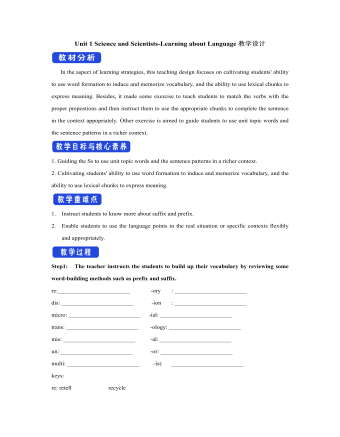
新人教版高中英语选修2Unit 1 Science and Scientists-Learning about Language教学设计
Step 7: complete the discourse according to the grammar rules.Cholera used to be one of the most 1.__________ (fear) diseases in the world. In the early 19th century, _2_________ an outbreak of cholera hit Europe, millions of people died. But neither its cause, 3__________ its cure was understood. A British doctor, John Snow, wanted to solve the problem and he knew that cholera would not be controlled _4_________ its cause was found. In general, there were two contradictory theories 5 __________ explained how cholera spread. The first suggested that bad air caused the disease. The second was that cholera was caused by an _6_________(infect) from germs in food or water. John Snow thought that the second theory was correct but he needed proof. So when another outbreak of cholera hit London in 1854, he began to investigate. Later, with all the evidence he _7_________ (gather), John Snow was able to announce that the pump water carried cholera germs. Therefore, he had the handle of the pump _8_________ (remove) so that it couldn't be used. Through his intervention,the disease was stopped in its tracks. What is more, John Snow found that some companies sold water from the River Thames that __9__________________ (pollute) by raw waste. The people who drank this water were much more likely _10_________ (get) cholera than those who drank pure or boiled water. Through John Snow's efforts, the _11_________ (threaten) of cholera around the world saw a substantial increase. Keys: 1.feared 2.when 3. nor 4.unless 5.that/which 6.infection 7.had gathered 8.removed 9.was polluted 10.to get 11. threat
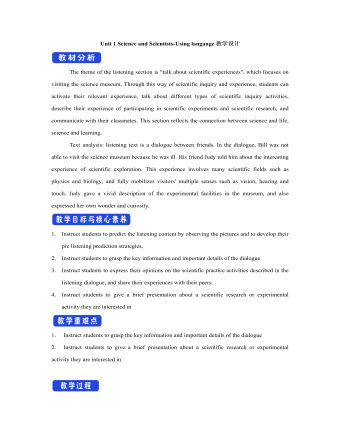
新人教版高中英语选修2Unit 1 Science and Scientists-Using langauge教学设计
This happens because the dish soap molecules have a strong negative charge, and the milk molecules have a strong positive charge. Like magnets, these molecules are attracted to each other, and so they appear to move around on the plate, taking the food coloring with them, making it look like the colors are quickly moving to escape from the soap.Listening text:? Judy: Oh, I'm so sorry that you were ill and couldn't come with us on our field trip. How are you feeling now? Better?? Bill: Much better, thanks. But how was it?? Judy: Wonderful! I especially liked an area of the museum called Light Games.it was really cool. They had a hall of mirrors where I could see myself reflected thousands of times!? Bill: A hall of mirrors can be a lot of fun. What else did they have?? Judy: Well, they had an experiment where we looked at a blue screen for a while, and then suddenly we could see tiny bright lights moving around on it. You'll never guess what those bright lights were!? Bill: Come on, tell me!? Judy: They were our own blood cells. For some reason, our eyes play tricks on us when we look at a blue screen, and we can see our own blood cells moving around like little lights! But there was another thing I liked better. I stood in front of a white light, and it cast different shadows of me in every color of the rainbow!? Bill: Oh, I wish I had been there. Tell me more!? Judy: Well, they had another area for sound. They had a giant piano keyboard that you could use your feet to play. But then, instead of playing the sounds of a piano, it played the voices of classical singers! Then they had a giant dish, and when you spoke into it, it reflected the sound back and made it louder. You could use it to speak in a whisper to someone 17 meters away.? Bill: It all sounds so cool. I wish I could have gone with you? Judy: I know, but we can go together this weekend. I'd love to go there again!? Bill: That sounds like a great idea!
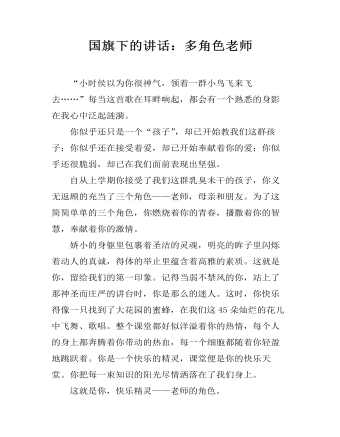
国旗下的讲话:多角色老师
“小时侯以为你很神气,领着一群小鸟飞来飞去……”每当这首歌在耳畔响起,都会有一个熟悉的身影在我心中泛起涟漪。你似乎还只是一个“孩子”,却已开始教我们这群孩子;你似乎还在接受着爱,却已开始奉献着你的爱;你似乎还很脆弱,却已在我们面前表现出坚强。自从上学期你接受了我们这群乳臭未干的孩子,你义无返顾的充当了三个角色——老师,母亲和朋友。为了这简简单单的三个角色,你燃烧着你的青春,播撒着你的智慧,奉献着你的激情。娇小的身躯里包裹着圣洁的灵魂,明亮的眸子里闪烁着动人的真诚,得体的举止里蕴含着高雅的素质。这就是你,留给我们的第一印象。记得当弱不禁风的你,站上了那神圣而庄严的讲台时,你是那么的迷人。这时,你快乐得像一只找到了大花园的蜜蜂,在我们这45朵灿烂的花儿中飞舞、歌唱。整个课堂都好似洋溢着你的热情,每个人的身上都奔腾着你带动的热血,每一个细胞都随着你轻盈地跳跃着。你是一个快乐的精灵,课堂便是你的快乐天堂。你把每一束知识的阳光尽情洒落在了我们身上。
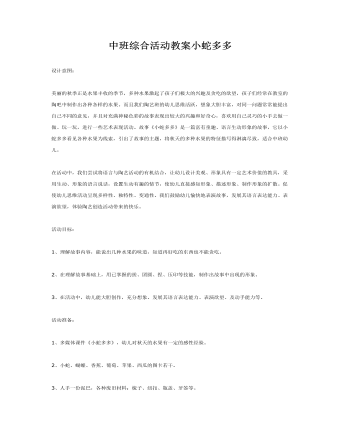
中班综合活动教案小蛇多多
在活动中,我们尝试将语言与陶艺活动的有机结合,让幼儿设计美观、形象具有一定艺术价值的教具,采用生动、形象的语言说话,设置生动有趣的情节,使幼儿直接感知形象、描述形象、制作形象的扩散。促使幼儿思维活动呈现多样性、独特性、变通性。我们鼓励幼儿愉快地表演故事,发展其语言表达能力、表演欲望,体验陶艺创造活动带来的快乐。活动目标:1、理解故事内容,能说出几种水果的味道,知道再好吃的东西也不能贪吃。2、在理解故事基础上,用已掌握的搓、团圆、捏、压印等技能,制作出故事中出现的形象。3、在活动中,幼儿能大胆创作,充分想象。发展其语言表达能力、表演欲望、及动手能力等。活动准备:1、多媒体课件《小蛇多多》,幼儿对秋天的水果有一定的感性经验。2、小蛇、蝴蝶、香蕉、葡萄、苹果、西瓜的图卡若干。3、人手一份泥巴,各种废旧材料:梳子、纽扣、瓶盖、牙签等。活动过程:一、语言活动——理解故事内容。师:1、美丽的秋天到了,小蛇多多想到外面去玩,于是它和妈妈打了个招呼。(导入故事情节,播放多媒体课件)
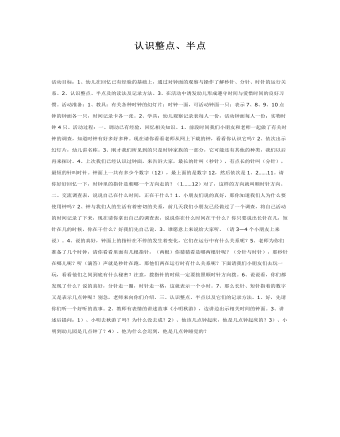
幼教大班数学教案-《认识整点和半点》
3、在活动中诱发幼儿形成遵守时间与爱惜时间的良好习惯。活动准备:1、教具:有关各种时钟的幻灯片;时钟一面,可活动钟面一只;表示7、8、9、10点钟的钟面各一只,时间记录卡各一张。2、学具:幼儿观察记录表每人一份,活动钟面每人一份;实物时钟4只。活动过程:一、调动已有经验,回忆相关知识。1、前段时间我们小朋友和老师一起做了有关时钟的调查,知道时钟有好多好多种。现在请你看看老师从网上下载的钟,看看你认识它吗?2、依次出示幻灯片,幼儿讲名称。3、刚才我们所见到的只是时钟家族的一部分,它可能还有其他的种类,我们以后再来探讨。4、上次我们已经认识过钟面,来告诉大家,最长的针叫(秒针),有点长的针叫(分针),最短的针叫时针。钟面上一共有多少个数字(12),最上面的是数字12,然后依次是1、2……11。请你好好回忆一下,时钟里的指针是朝哪一个方向走的?(1……12)对了,这样的方向就叫顺时针方向。二、交流调查表,说说自己在什么时间,正在干什么?1、小朋友们说的真好,那你知道我们人为什么要使用钟吗?2、钟与我们人的生活有着密切的关系,前几天我们小朋友已经做过了一个调查,将自己活动的时间记录了下来,现在请你拿出自己的调查表,说说你在什么时间在干什么?你只要说出长针在几,短针在几的时候,你在干什么?好我们先自己说。3、谁愿意上来说给大家听。(请3—4个小朋友上来说)。
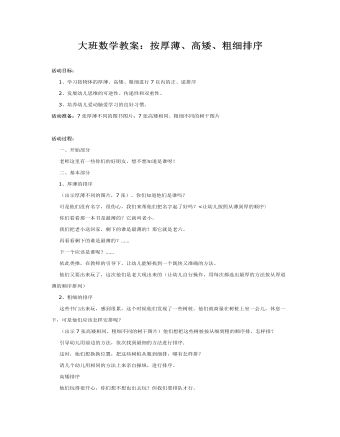
大班数学教案:按厚薄、高矮、粗细排序
2、发展幼儿思维的可逆性、传递性和双重性。 3、培养幼儿爱动脑爱学习的良好习惯。活动准备:7张厚薄不同的图书图片;7张高矮相同、粗细不同的树干图片 活动过程: 一、开始部分 老师这里有一些你们的好朋友,想不想知道是谁呀! 二、基本部分 1、厚薄的排序 (出示厚薄不同的图片,7张)。你们知道他们是谁吗? 可是他们没有名字,很伤心,我们来帮他们把名字起了好吗?<让幼儿按照从薄到厚的顺序〉
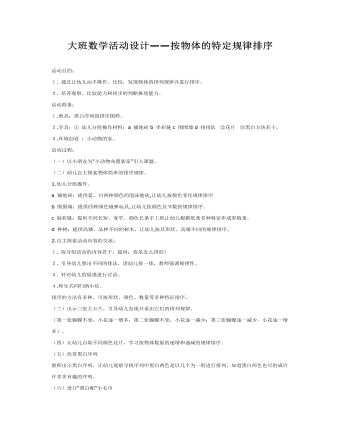
大班数学教案:按物体的特定规律排序
2. 培养观察、比较能力和初步的判断推理能力。活动准备: 1.教具:黑白序列的排序图样。2.学具:①幼儿分组操作材料:a 铺地砖b 串彩链c 围围墙d 排排队 ②花片 ③黑白方块若干。3.环境创设:小动物的家。活动过程:(一)以小朋友为“小动物布置新家”引入课题。(二)幼儿自主探索物体简单的排序规律。1.幼儿分组操作。a 铺地砖:提供蓝、白两种颜色的泡沫地砖,让幼儿按颜色变化规律排序 b 围围墙:提供四种颜色炮弹玩具,让幼儿按颜色及节数按规律排序。c 做彩链:提供不同长短、宽窄、颜色长条手工纸让幼儿根据纸条多种特征串成彩链条。d 种树:提供高矮、品种不同的树木,让幼儿按其形状、高矮不同的规律排序。
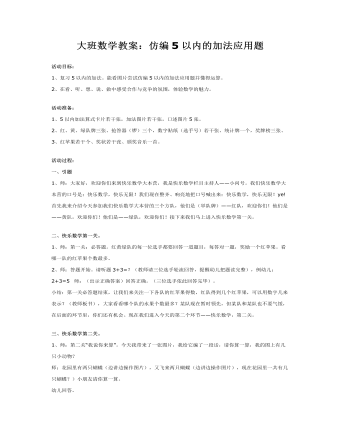
大班数学教案:仿编5以内的加法应用题
活动准备: 1、5以内加法算式卡片若干张,加法图片若干张,口述图片5张。 2、红、黄、绿队牌三张、抢答器(锣)三个,数字贴纸(选手号)若干张、统计牌一个,奖牌榜三张、 3、红苹果若干个、奖状若干张、颁奖音乐一首。 活动过程: 一、引题 1、师:大家好,欢迎你们来到快乐数学大本营,我是快乐数学栏目主持人——小问号。我们快乐数学大本营的口号是:快乐数学,快乐无限!我们现在整齐、响亮地把口号喊出来:快乐数学,快乐无限!ye! 首先我来介绍今天参加我们快乐数学大本营的三个方队,他们是(举队牌)——红队,欢迎你们!他们是——黄队,欢迎你们!他们是——绿队,欢迎你们!接下来我们马上进入快乐数学第一关。 二、快乐数学第一关。 1、师:第一关:必答题。红黄绿队的每一位选手都要回答一道题目,每答对一题,奖励一个红苹果。看哪一队的红苹果个数最多。 2、师:答题开始。请听题3+3=?(教师请三位选手轮流回答,提醒幼儿把题读完整),例幼儿:2+3=5 师:(出示正确答案)回答正确。(三位选手依此回答完毕)。
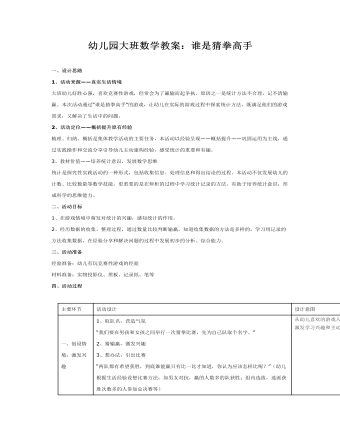
幼儿园大班数学教案:谁是猜拳高手
2、活动定位——概括提升原有经验梳理、归纳、概括是集体教学活动的主要任务,本活动以经验呈现——概括提升——巩固运用为主线,通过实践操作和交流分享引导幼儿主动建构经验,感受统计的重要和有趣。3、教材价值——培养统计意识,发展数学思维统计是探究性实践活动的一种形式,包括收集信息、处理信息和得出结论的过程。本活动不仅发展幼儿的计数、比较数量等数学技能,更重要的是在辩析的过程中学习统计记录的方法,有助于培养统计意识,形成科学的思维能力。二、活动目标1、在游戏情境中萌发对统计的兴趣,感知统计的作用。2、经历数据的收集、整理过程,通过数量比较判断输赢。知道收集数据的方法是多样的,学习用记录的方法收集数据,在经验分享和解决问题的过程中发展初步的分析、综合能力。三、活动准备经验准备:幼儿有玩竞赛性游戏的经验材料准备:实物投影仪、黑板、记录纸、笔等


